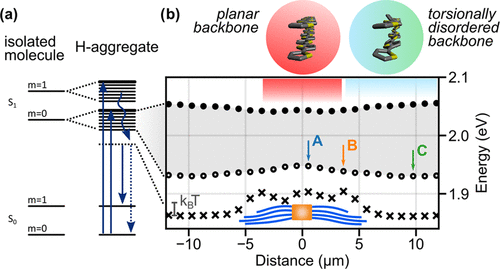
In the field of organic optoelectronics, enhancing the diffusion of excitons has been a longstanding research focus [1], due to its crucial role in the functionality of (e.g.) organic solar cells and OLEDs. However, directing these randomly diffusing excitons towards a specific target requires precise modification of the nanometer-scale assembly of organic materials. In a recent JACS publication with our colleagues from Bayreuth, we present a fresh approach to inscribe such energy-gradients into P3HT-nanofibers:
Stäter, S. et al. “Directed Gradients in the Excited-State Energy Landscape of Poly(3-hexylthiophene) Nanofibers.” Journal of the American Chemical Society
For sample fabrication, we employ a needle-like nucleation seed that initiates the growth of P3HT-nanofibers in solution, resulting in a configuration resembling shish-kebab superstructures [2]. Our approach produces P3HT-nanofibers that exhibit remarkable length (several µm), parallel alignment, and close proximity.
We use hyperspectral imaging to collect 1680 PL and absorption spectra, comprehensively characterizing a 40x40µm area containing the superstructure. Analyzing the optical properties measured along nanofibers results in the energy landscape shown below:

Figure: Excited-state energy landscape along P3HT nanofibers within a NA/P3HT superstructure. Adopted without changes from Stäter et al., under CC BY-NC-ND 4.0 license.
Note that the location of the superstrucutre is shown schematically on the bottom of the graph: The P3HT-nanofibers (blue) extend around 5µm left and right from the needle-like nucleation seed (orange square, shown as cross-section). Plotted above this, we see how the edges of the exciton band are modified by the presence of the superstructure, leading to an energy-gradient along the P3HT-nanofibers.
We attribute the continuous variation of energy levels along these P3HT-nanofibers to defect-fractionation during nanofiber growth, as described by Oosterbaan et al. and Roehling et al [3, 4]. We hope that our approach, which involves employing a specialized nucleation seed to induce fiber growth in solution, will facilitate the design of systems that achieving directed long-range exciton transport.
-
Haedler, A. T.; Kreger, K.; Issac, A.; Wittmann, B.; Kivala, M.; Hammer, N.; Köhler, J.; Schmidt, H.-W.; Hildner, R. Long-Range Energy Transport in Single Supramolecular Nanofibres at Room Temperature. Nature 2015, 523 (7559), 196–199. https://doi.org/10.1038/nature14570. ↩︎
-
Brinkmann, M.; Chandezon, F.; Pansu, R. B.; Julien-Rabant, C. Epitaxial Growth of Highly Oriented Fibers of Semiconducting Polymers with a Shish-Kebab-Like Superstructure. Advanced Functional Materials 2009, 19 (17), 2759–2766. https://doi.org/10.1002/adfm.200900966. ↩︎
-
Oosterbaan, W. D.; Vrindts, V.; Berson, S.; Guillerez, S.; Douhéret, O.; Ruttens, B.; D’Haen, J.; Adriaensens, P.; Manca, J.; Lutsen, L.; Vanderzande, D. Efficient Formation, Isolation and Characterization of Poly(3-Alkylthiophene) Nanofibres: Probing Order as a Function of Side-Chain Length. J. Mater. Chem. 2009, 19 (30), 5424. https://doi.org/10.1039/b900670b. ↩︎
-
Roehling, J. D.; Arslan, I.; Moulé, A. J. Controlling Microstructure in Poly(3-Hexylthiophene) Nanofibers. J. Mater. Chem. 2012, 22 (6), 2498–2506. https://doi.org/10.1039/C2JM13633C. ↩︎




